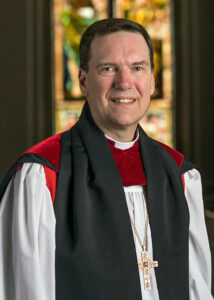The Rt. Rev. W. Nicholas Knisely
One of the gifts of the ministry of a bishop is to get to personally experience the support ministries of every congregation in the diocese we serve. After a dozen years of ministry here in Rhode Island, I have been in every Episcopal sacristy in the state, and I have witnessed the dedicated ministry of all of our altar guilds.
What’s most striking to me is the variety of spaces that are an integral part of that ministry. Some sacristies are large, spacious, well lit, and carefully laid out. There’s plenty of room to work and ample storage for all the vessels and vestments. Bulletin boards are filled with notes, and an assortment of manuals and worship books are neatly arranged on the shelves. Some of our sacristies here in the Ocean State remind me that when the buildings were erected, whaling and shipbuilding were major local industries. Those sacristies are often paneled with shiplap and are neat and efficient like the galley on a boat. None of the space is wasted; closets and cupboards have just enough space for their sacred cargo, and if there are two or more people trying to work in the space, it’s pretty tight quarters.
The sacristy and the way the various altar guilds use them is one of the things that I look for to see what the congregation values and how it orders its common life. And in turn, that is a clue to how the larger community in which the congregation is located understands itself. Some sacristies, especially those in college towns, tend to have reference books and procedure guides. Smaller and/or rural churches have thank you notes, children’s drawings, and prayer cards scattered around or taped to the wall. Historical parishes have valuable silver or gold Eucharistic vessels in the safe — more modern and often more progressive congregations will have ceramic ones.
It’s the diversity of these settings that I so cherish as a bishop. It’s a visual and experiential reminder of the breadth of worship and liturgical expression in our diocese, and by extension, in our denomination. High Church and Low Church, modern and ancient, Evangelical and Progressive are all parts of our common life; the loss of any part would diminish who we are as an expression of the Via Media, the Anglican Middle Way.
I hope you can recognize some features of your sacristy in what I’ve written here. And I hope that maybe you can recognize the features of some other congregations’ sacristies as well. I wonder, though, if we can do more to encourage altar guilds to visit other churches’ sacristies, both Episcopalian and those of congregations in other denominations. There’s so much to learn about how we and our neighbors live out the Gospel in the deceptively simple spaces in which this work is carried out. All it takes is some time to visit and a bit of holy curiosity.
Blessings on you and your work.

